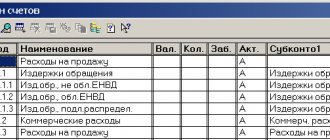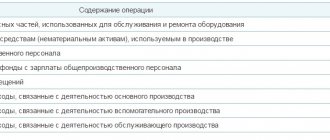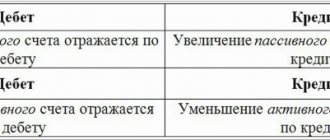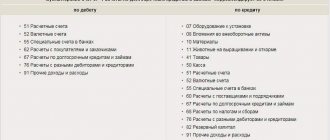Regulatory framework
The legal basis on which organizations must sell and then record goods is PBU 9/99 (Order of the Ministry of Finance of Russia No. 32n dated 05/06/1999). In it, the accountant will be able to find the answer to all questions regarding the sale of manufactured products or services provided. Organizations divide income into:
- ordinary - from the main activities;
- others - not related to the main activity, not always regular, insignificant in the total volume of profitability from the sale of products.
Ordinary income also includes profitability from trade in goods, works and services (clause 5 of PBU 9/99). The amount of income is calculated without value added tax and VAT (clause 3 of PBU 9/99). Personal income tax is also not taken into account in this case. Each institution chooses the procedure for dividing income independently, based on the specifics of the type of activity and legal form. The chosen method must be fixed in the accounting policy (clause 4 of PBU 9/99).
Clause 12 of PBU 9/99 states that revenue from trade is recognized in accounting only if the following characteristics are simultaneously determined:
- the enterprise has the right to receive it;
- it is calculated in a certain amount;
- the income is beneficial for its recipient;
- upon sale, a transfer of ownership was carried out;
- the value of sales costs is also known.
For organizations operating under a simplified accounting scheme, it is possible to recognize profitability at the time of receipt of payment for goods and services. In cases of a long production cycle, revenue can also be recognized in stages - after completing a certain stage or manufacturing a specific part (clause 13 of PBU 9/99).
What are business expenses when you have a store?
I believe the idea is understood: everything that contributes to the sale of goods, services, works and products is considered a business expense. However, it is worth remembering that all company expenses must be aimed at carrying out activities and be justified. For example, long-distance telephone conversations between an employee working in a store and relatives during working and non-working hours can hardly be classified as business expenses. It will be extremely difficult, if not impossible, for tax authorities to justify such expenses. Unless a relative is a major dealer of your services, products or goods.
To summarize this article, I would like to draw your attention to the main idea: “Business expenses include those expenses of a company that are aimed at SELLING and the opportunity to MAKE A SALE of its goods, services and products.” In the next article, what is included in the commercial expenses of enterprises, we will take a closer look at how this happens in trade, production, services, and work performance
At the same time, we will try to solve the problem orally.
Which accounts should be used to record sales?
Accounting for transactions for the sale of goods and services of an organization is reflected in account 90 “Sales” of the chart of accounts (Order of the Ministry of Finance No. 94n dated October 31, 2000). Account 90 records transactions for the sale of inventory and materials and expenses directly related to the sale of goods and materials, as well as VAT accrued on these transactions. On the account 90 you can maintain both synthetic and analytical accounting. Analytics is carried out according to such parameters as the types of industrial and technical works being sold and the structural divisions of the organization.
Account 90 has a number of sub-accounts that the organization opens based on the industry and production specifics of its scope of operation:
- revenue - 90.1;
- cost - 90.2;
- VAT - 90.3;
- excise taxes - 90.4;
- expenses - 90.5;
- profit and loss - 90.9.
Indicators and movements in subaccounts are taken into account throughout the month on an accrual basis. At the end of the reporting period - month - loan turnover (subaccount 90.1) is compared with the total debit turnover for subaccounts such as 90.2, 3, etc. The result is posted in the “Profit and Loss” subaccount with the following entry: Dt 90.9 Kt 99.
Line 2210 “ Business expenses
”
Manufacturing firms in this line reflect the costs associated with the sale of products (works, services). Such costs are taken into account in the debit of account 44 “Sales expenses”.
Trading companies on line 2210 reflect the amount of distribution costs. They are also recorded in the debit of account 44 “Sales expenses”. These expenses are indicated on line 2210 “ Business expenses
”, if they are written off from the credit of account 44 to the debit of account 90, subaccount 2 “Cost of sales”. Thus, in line 2210 you need to reflect the debit turnover in subaccount 90-2 in correspondence with account 44 “Sales expenses” for the reporting period. Indicate the amount of business expenses (distribution costs) in the income statement in parentheses.
Manufacturing companies include the following expenses as business expenses:
• for product advertising; • for transportation of products to their destination; • for loading and unloading of products; • for packaging of finished products; • for the maintenance of premises for storing products at points of sale and warehouse services; • for entertainment expenses; • to pay salaries to sellers, etc.
Formation of expenses
When forming business expenses in accounting, companies make the following entries:
DEBIT 44 CREDIT 10 - materials for packaging products in the warehouse were written off;
DEBIT 44 CREDIT 23 - expenses of auxiliary production for packaging, as well as delivery and loading of products are written off;
DEBIT 44 CREDIT 70 - wages accrued to employees involved in packaging, loading and selling products;
DEBIT 44 CREDIT 69 - insurance contributions to extra-budgetary funds and a contribution for insurance against industrial accidents and occupational diseases were accrued from the wages of workers involved in packaging, loading and selling products;
DEBIT 44 CREDIT 60, 76 - costs of delivery and loading of products by third-party organizations, costs of marketing research, advertising, remuneration to intermediary organizations, etc. are taken into account.
Example
ZAO Aktiv produces products. In the reporting year, employees of the finished product sales department received a salary in the amount of 150,000 rubles. In the same year, the organization conducted an advertising campaign. The expenses for it amounted to 35,400 rubles. (including VAT - 5400 rubles).“Aktiv” pays contributions for insurance against industrial accidents and occupational diseases at a rate of 1%, and contributions to the Pension Fund, Social Insurance Fund, and Federal Compulsory Medical Insurance Fund at a rate of 30%.
The Aktiva accountant made the following entries:
DEBIT 44 CREDIT 70 - 150,000 rub. — salaries were accrued to employees of the finished product sales department;
DEBIT 44 CREDIT 69 - 1500 rub. (RUB 150,000 x 1%) - a premium has been added for insurance against industrial accidents and occupational diseases;
DEBIT 44 CREDIT 69 - 45,000 rub. (RUB 150,000 x 30%) - contributions to the Pension Fund, Social Insurance Fund, and Federal Compulsory Medical Insurance Fund have been accrued;
DEBIT 44 CREDIT 60 - 30,000 rub. (35,400 - 5400) - reflects the costs of conducting an advertising campaign;
DEBIT 19 CREDIT 60 - 5400 rub. — VAT on the costs of the advertising campaign is taken into account;
DEBIT 68 subaccount “Calculations for VAT” CREDIT 19 - 5400 rub. — VAT deduction has been made;
DEBIT 60 CREDIT 51 - 35,400 rub. — paid advertising costs;
DEBIT 90-2 CREDIT 44 - 226,500 rub. (150,000 + 1500 + 45,000 + 30,000) - business expenses
.
On line 2210 “ Business expenses
» In the profit and loss report for the reporting year, the accountant must reflect the amount of 227 thousand rubles. (RUB 226,500).
Write-off of expenses
Business expenses
written off as cost in different ways. The way they are written off depends on many factors. In particular, on the procedure for transferring ownership of shipped products.
If this occurs after the product has been shipped to the buyer, business expenses
write off directly to the debit of account 90, subaccount 2 “Cost of sales”.
If, under a supply agreement, ownership of the shipped products passes to the buyer only after payment, commercial expenses
can be written off only after the money has been received.
Reflect the write-off of expenses by posting: DEBIT 90-2 CREDIT 44 - business expenses
.
Packaging and transportation costs that are part of business expenses may:
• distributed between sold and unsold products; • written off completely.
Cost Allocation
Such costs must be allocated to the specific types of products shipped.
If it is impossible to determine which product these costs relate to, then distribute them based on weight, volume, production cost or other characteristic indicators.
Establish a specific procedure for distributing expenses in your accounting policy.
Example
In the reporting year, the warehouse of Aktiv CJSC received 6,000 units of finished products, including:• products “A” - 1500 units; • products “B” - 2000 units; • products “C” - 2500 units.
The total amount of business expenses for the year amounted to 28,000 rubles. (including costs for packaging and transportation of products in the warehouse - 12,000 rubles, other commercial expenses - 16,000 rubles).
According to Aktiva's accounting policy, packaging and transportation costs are distributed between types of products in proportion to the volume of their output.
According to the supply agreement, ownership of the product passes to the buyer after payment. During the reporting period, products “A” and “B” were shipped and paid for in full by customers. No payment was received from buyers for product “C”.
. Aktiva's accountant reflected business expenses
wiring:
DEBIT 44 CREDIT 10 (60, 69, 70...) - 28,000 rub. — business expenses
.
Packaging and transportation costs for each type of product are distributed as follows:
• products “A” 1500 units. : 6000 units x 12,000 rub. = 3000 rub.; • products “B” 2000 units. : 6000 units x 12,000 rub. = 4000 rub.; • products “C” 2500 units. : 6000 units x 12,000 rub. = 5000 rub.
Packaging and transportation costs related to sold products “A” and “B” will amount to RUB 7,000. (3000 + 4000). The total amount of business expenses written off to the debit of account 90 will be 23,000 rubles. (7000 + 16,000).
The Aktiva accountant made an entry in the accounting: DEBIT 90-2 CREDIT 44 - 23,000 rubles. - business expenses
.
On line 2210 “ Business expenses
” of the profit and loss report for the reporting year, the accountant indicated the amount of 23 thousand rubles.At the end of the reporting year, the company’s accounting records on account 44 the balance of commercial expenses, which relates to products “C”, in the amount of 5,000 rubles. (28,000 - 23,000). This amount (5 thousand rubles) must be indicated on line 1210 of the balance sheet for the reporting year.
Write off expenses completely
In accordance with paragraph 9 of PBU 10/99, commercial and administrative expenses can be fully included in the cost of products sold if they are recognized as expenses for ordinary activities.
If a company has switched to this write-off procedure since the beginning of the year, then it must write off the unwritten-off balance of business expenses for the previous reporting period to account 84 “Retained earnings (uncovered loss)” (clause 15 of PBU 1/2008).
Example
Passive LLC produces products. According to the accounting policy for the reporting year, commercial expensesare recognized as expenses for ordinary activities and are fully included in the cost of products sold. At the beginning of the year, the balance of business expenses in the amount of 6,000 rubles is recorded in the “Liability” account.
The Liability accountant will write off this amount by posting: DEBIT 84 CREDIT 44
— 6000 rub. — the balance of business expenses is written off due to changes in accounting policies. The amount of business expenses for the reporting year amounted to 30,000 rubles.
In the reporting year, Passive did not sell all of its products. However, in accordance with the accounting policy, the entire amount of business expenses for the year should be written off as a debit to subaccount 90-2.
On line 2210 “ Business expenses
» In the profit and loss report for the reporting year, the accountant will reflect the amount of expenses in the amount of 30 thousand rubles. For the past year, the amount of business expenses for this line of the report must be reduced by 6,000 rubles.
How to account for business expenses
trading companies
If you have a trading company, then on line 2210 “ Business expenses
“You need to reflect the costs written off to the debit of account 90, subaccount 2 “Cost of sales”, from the credit of account 44 “Sales expenses”.
On account 44 in trading companies, all costs associated with conducting ordinary activities are taken into account:
• salaries of administrative and management personnel and salespeople; • expenses for renting office space and warehouses; • cost of security services; • entertainment expenses, etc.
In addition, trading companies can record transportation costs associated with the purchase of goods on account 44.
Formation of expenses
When forming business expenses in the accounting of a trading company, the following entries are made:
DEBIT 44 CREDIT 10 - materials for packaging goods are written off; DEBIT 44 CREDIT 41 subaccount “Containers under goods and empty” - reflects the issue (consumption) of containers; DEBIT 44 CREDIT 02 (05, 60, 76...) - expenses associated with conducting trading activities are taken into account (depreciation, costs of marketing research, advertising, remuneration to intermediary organizations, etc.); DEBIT 44 CREDIT 70 - wages accrued to employees of the trading company; DEBIT 44 CREDIT 69 - contributions to the Pension Fund, Social Insurance Fund, Federal Compulsory Medical Insurance Fund and contributions for insurance against accidents and occupational diseases are accrued from employees' salaries.
Example
CJSC Aktiv is engaged in trading. In the reporting year, the company's employees received a salary of 300,000 rubles. In the same year, the organization conducted an advertising campaign. The expenses for it amounted to 70,800 rubles. (including VAT - 10,800 rubles). “Aktiv” pays contributions for insurance against industrial accidents and occupational diseases at a rate of 0.2%, and contributions to the Pension Fund, Social Insurance Fund, and Federal Compulsory Medical Insurance Fund at a rate of 30%. The Aktiva accountant made the following entries:
DEBIT 44 CREDIT 70 - 300,000 rub. — salaries of employees were accrued;
DEBIT 44 CREDIT 69 - 600 rub. (RUB 300,000 x 0.2%) - a premium has been added for insurance against industrial accidents and occupational diseases;
DEBIT 44 CREDIT 69 - 90,000 rub. (RUB 300,000 x 30%) - contributions to the Pension Fund, Social Insurance Fund, and Federal Compulsory Medical Insurance Fund have been accrued;
DEBIT 44 CREDIT 60 - 60,000 rub. (70,800 - 10,800) - reflects the costs of conducting an advertising campaign;
DEBIT 19 CREDIT 60 - 10,800 rub. — VAT on the advertising campaign is taken into account;
DEBIT 68 subaccount “Calculations for VAT” CREDIT 19 - 10,800 rubles. — VAT deduction has been made;
DEBIT 90-2 CREDIT 44 - 450,600 rub. (300,000 + 600 + 90,000 + 60,000) - business expenses
.
On line 2210 “ Business expenses
» In the profit and loss report for the reporting year, the accountant must reflect the amount of 451 thousand rubles.
Write-off of expenses
All business expenses
Firms write off monthly to account 90, subaccount 2 “Cost of sales”. An exception is provided for transportation costs associated with the purchase of goods.
In accounting, these expenses can be reflected in two ways:
• directly on account 41 “Goods” (that is, include in the actual cost of purchased goods); • on account 44 “Sales expenses”.
If the company’s accounting policy provides for the inclusion of transportation costs in the cost of goods, then they are reflected in line 2120 “Cost of sales” of the income statement.
When accounting for transportation costs on account 44 “Sales expenses”, reflect them on line 2210 “ Sales expenses
».
For profit tax purposes, trading organizations have the right to keep records of expenses in the same way as in accounting. The procedure for forming the cost of purchased goods (including the inclusion of delivery costs or attributing the costs of delivery of sold goods to distribution costs) is established by the accounting policy for tax purposes (Article 320 of the Tax Code of the Russian Federation).
Not all transport costs reflected in the debit of account 44 are written off to the cost of sales, but only their part, which relates to goods sold.
You can calculate it like this:
1) to the balance of transport costs at the beginning of the month, add the transport costs incurred in the reporting month; 2) determine the amount of goods sold in the reporting month and the balance of goods at the end of the month; 3) divide the amount of transportation costs (item 1) by the amount of goods sold and remaining goods (item 2). In this way, the average percentage of transport costs in relation to the total cost of goods will be calculated; 4) multiply the balance of goods at the end of the reporting month by the average percentage of transportation costs. The result was the amount of transportation costs related to the balance of unsold goods at the end of the month; 5) find the difference between the entire amount of transportation costs incurred and that part of them that relates to the balance of unsold goods (clause 4). Write off the resulting difference from the credit of account 44 to the debit of account 90, subaccount 2 “Cost of sales”.
After calculating the amount of transportation costs to be written off, make the following entry in your accounting:
DEBIT 90-2 CREDIT 44 - part of the transportation costs related to goods sold is written off.
Example
The balance of transportation costs in the wholesale trade organization Passive LLC at the beginning of March of the reporting year is 10,000 rubles. (account 44, subaccount “Transportation expenses”).In March, 70,000 rubles were spent on the delivery of goods, and these transport costs are not included in the price of the goods. The balance of unsold goods at the end of March (account 41 balance) amounted to 120,000 rubles. In March, goods worth 300,000 rubles were sold.
The amount of transportation expenses that needs to be written off for the reporting month was determined by the accountant as follows:
1. the amount of transportation costs at the beginning of March and for March amounted to 80,000 rubles. (10,000 + 70,000); 2. the cost of the balance of unsold goods at the end of March and goods sold in March is equal to 420,000 rubles. (120,000 + 300,000); 3. the average percentage of transportation costs was 19.05% (80,000 rubles: 420,000 rubles x 100%); 4. the balance of transportation costs attributable to the balance of unsold goods is equal to 22,860 rubles. (RUB 120,000 x 19.05%); 5. transportation costs subject to write-off to cost in March amount to 57,140 rubles. (80,000 - 22,860).
The following entry was made in accounting: DEBIT 90-2 CREDIT 44 - 57,140 rubles. — part of the transportation costs for goods sold is written off. Amount 57 thousand rubles. will be included in line 2210 “ Business expenses
» profit and loss statement.
How to account for sales of goods
The accounting record of sold inventory items is made at the time of shipment of goods. Accounting procedures for the sale of goods are as follows:
| Debit | Credit | Description |
| 62 | 90.1 | Revenue received from product sales |
| 90.2 | 41 | Write-off of the cost of goods sold |
| 90.5 | 44 | Write-off of costs associated with the sale |
| 51 | 62 | Receiving payment from the customer |
If, under the terms of the agreement, the transfer of ownership of sold goods and materials from the seller to the buyer is carried out at the time of payment, then, on the basis of clause 12 of PBU 9/99 (subclause “d”), revenue is not recognized at the time of delivery of the goods. When reflecting shipment and sale transactions, invoices are used. 45. Accounting entries for the sale of goods and services will be as follows:
| Posts | Transaction data |
| Dt 45 Kt 41 | Shipment of goods and materials to the customer |
| Dt 76 Kt 68 | VAT calculation |
| Dt 51 Kt 62 | Receipt of payment to the seller |
| Dt 62 Kt 90.1 | Revenue recognition |
| Dt 90.2 Kt 45 | Write-off of cost of goods and materials |
| Dt 90.3 Kt 76 | VAT credit accrued upon shipment |
| Dt 90.5 Kt 44 | Write-off of sales costs |
How to write off selling expenses
In the first case, the costs of packaging and packing are included in the cost of goods as the costs of bringing them to a state in which they are suitable for use. Since such expenses arise after the goods have been capitalized, their value, reflected in account 41 upon receipt, changes. This does not contradict accounting legislation (clause
6
PBU 5/01), but with this approach, temporary differences will arise between accounting and tax accounting. The fact is that for calculating income tax, the costs of packaging and packing are indirect. When calculating the tax base, they are fully recognized in the reporting period in which the organization committed them (para.
3 tbsp. 320 of the Tax Code of the Russian Federation). In accounting, expenses recorded on account 41 are written off as goods are sold (Instructions for the chart of accounts).
How to account for services
Services are considered transferred immediately at the time of their provision. Use the following accounting records for the sale of services:
| Accounting in accounting | Content |
| Dt 62 Kt 90.1 | Reflection of revenue |
| Dt 90.2 Kt 20, 23, 29, etc. | Write-off of cost |
| Dt 90.3 Kt 68 | VAT accrual on the price of the service provided |
| Dt 90.5 Kt 44 | Write off costs |
| Dt 51 Kt 62 | Receiving payment from the customer |
What is included in management expenses
The rules for recognition and division of costs are fixed in PBU 10/99. The managerial type of expenses includes funds allocated to pay office staff, pay off obligations on bills for communication services, security alarms, housing and communal services, etc. Administrative expenses include a wide range of costs that are not directly related to the production of products, they are not used in the process of activities in the field of trade or services.
Examples of this type of cost could be:
- paid bills for office supplies;
- conducting seminars and trainings for company employees;
- entertainment expenses;
- depreciation charges for fixed assets used at administrative facilities;
- maintenance and repair of equipment intended for operation by management personnel.
Everything that relates to management costs can be included in the cost of production in two ways:
- write-off as goods manufactured by the enterprise are sold;
- write-off of the full amount of costs incurred, linked to the period of their occurrence.
How are selling expenses different from administrative expenses? The need for the former is determined by the trading activities carried out by the company, the latter are needed to maintain the administrative apparatus of the company. Business expenses may include funds transferred to packaging suppliers, payment for services for packaging products, loading and delivery. Management costs are characterized by predictability, their predicted volume can be approximately calculated, commercial expenses are characterized by dependence on the number of products produced and sold.
How the implementation is adjusted
If the terms of the contract for the supply of industrial and industrial components have been changed or the accounting department has discovered a previously made error, then the accounting of sales operations can be changed in accordance with the legally established regulations. The parties can send the accompanying documentation necessary for the adjustment by e-mail (mail), and then hand over the original documents in person.
Postings for adjusting the implementation downward:
- reversal Dt 62 Kt 90.1 - decrease in revenue;
- reversal Dt 90.3 Kt 68 - deduction for the amount of the required difference;
- reversal Dt 20 Kt 60 - reduction of the buyer’s debt;
- reversal Dt 19 Kt 60 - VAT on the amount of the difference;
- Dt 19 Kt 68 - restoration of value added tax.
Expenses for selling transactions are written off for sales
The cost of the batch is 500,000 rubles. (excluding VAT). Before selling granulated sugar at retail, the organization packages it in 1 kg plastic bags. For these purposes, Hermes purchased packaging bags for a total amount of 8,000 rubles. (excluding VAT). Other expenses for packaging and packing sugar amounted to 10,000 rubles. To account for packaging, a subaccount “Containers under goods and empty” (41-3) was opened for account 41 “Goods”; for accounting for goods, a subaccount “Goods in warehouses” (41-1) was opened. The following entries were made in the organization’s accounting: Debit 41-1 Credit 60–500,000 rub. – granulated sugar was capitalized; Debit 41-3 Credit 60–8000 rub. – plastic bags for packaging sugar were capitalized; Debit 44 Credit 41-3– 8000 rub. – the cost of packages used for packaging has been written off; Debit 44 Credit 70 (69, 76...) – 10,000 rub. – expenses associated with packaging and packaging of granulated sugar were written off.





